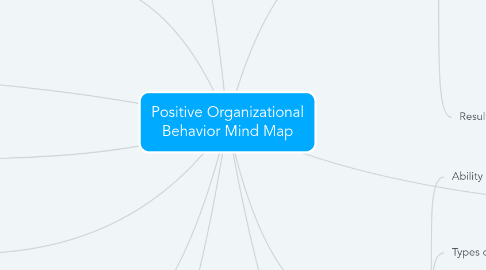
1. Hope
1.1. Willpower and pathways
1.1.1. Agency
1.2. Goal setting
1.2.1. Stretch goals
1.2.2. Approach goals
1.2.3. Avoidance goals
1.2.4. Stepping
1.2.5. Regular Feedback
1.3. Mental Rehearsals
1.3.1. Rituals
1.3.2. Involvment
1.4. Potential Pitfalls
1.4.1. Absence of realism
1.4.1.1. False Hope Syndrome
1.4.2. End-justify-means mentality
1.4.3. Compromising ethical values
2. Approaches to OB
2.1. Systems Perspective
2.2. Contingency Approach
3. Negative focus
3.1. Negativity bias
3.1.1. Negativity emotions are stronger
3.2. The Disease Model
3.2.1. "What's wrong with people?"
3.3. Sunk-cost fallacy
4. Positive Psycology
4.1. Martin Seligman
4.1.1. Caracter strengts
4.1.1.1. Wisdom
4.1.1.2. Courage
4.1.1.3. Humanity
4.1.1.4. Justice
4.1.1.5. Temperance
4.1.1.6. Transcendence
4.2. Flow state
5. Motivational theories
5.1. Theory Y and X
5.2. Herzberg Two Factor
5.3. Seligman
5.4. Maslow
5.5. Reinforcement theory
6. Aristotle's Doctrine of Mean
6.1. Optimal point is between the extremes
6.2. Too much or too little of something is negative
7. Grit
7.1. Long term goals
7.2. Necessary but not a sufficient condition for succes
7.3. Sunk-cost fallacy
7.4. Fixed and growth mindset
8. Resilience
8.1. Ability to bounce back
8.2. Types of resilience
8.2.1. Natural (a trait)
8.2.2. Adaptive (build on circumstances)
8.2.3. Restored (build trough proactive techniques)
8.3. Four factor model of resilience
8.4. Seligman's 3P's of resilience model
8.4.1. Personalisation
8.4.2. Pervasiveness
8.4.3. Performance
9. Optimism
9.1. Attributional style
9.1.1. Stable or unstable
9.1.2. Global or local
9.1.3. Internal vs external
9.1.4. Explanatory style
9.1.4.1. Optimist
9.1.4.1.1. Positive events are internal, stable, global
9.1.4.1.2. Negative events are external, unstable and local
9.1.4.2. Pessimist
9.1.4.2.1. Negative events are internal, stable, global
9.1.4.2.2. Positive events are external, unstable, and global
9.2. Learned Optimism (Seligman)
9.2.1. Even pessimist can become optimistic
9.2.1.1. This is good news!
9.2.2. ABCDE model
9.2.2.1. Adversity
9.2.2.2. Beliefs
9.2.2.3. Consequences
9.2.2.4. Disputation
9.2.2.5. Energization
9.2.3. Developing PsyCap optimism
9.3. Potential Pitfalls
9.3.1. Illusion of unique invulnerability
10. Efficacy
10.1. Bandura
10.2. Mastery Experience
10.2.1. Succes in the past
10.3. Vicarious Experiences
10.3.1. Observing others
10.3.2. Role-models
10.4. Verbal persuation
10.4.1. Pep talks
10.4.1.1. Credibility of the pep talker
10.4.2. Feedback
10.5. Physiological States
10.6. Potential Pitfalls
10.6.1. False efficacy
10.6.2. Perceptual biases
10.6.3. Attributional biases
10.7. Results from high self efficacy
10.7.1. Setting challenging goals
10.7.2. Confidence
10.7.3. Staying committed
10.7.4. High effort
11. Psychological Capital
11.1. "HERO effect"
11.2. Consequences
11.2.1. Commitment
11.2.2. Well-being
11.2.3. Creativity
11.2.4. Performance
11.2.5. And much more!
